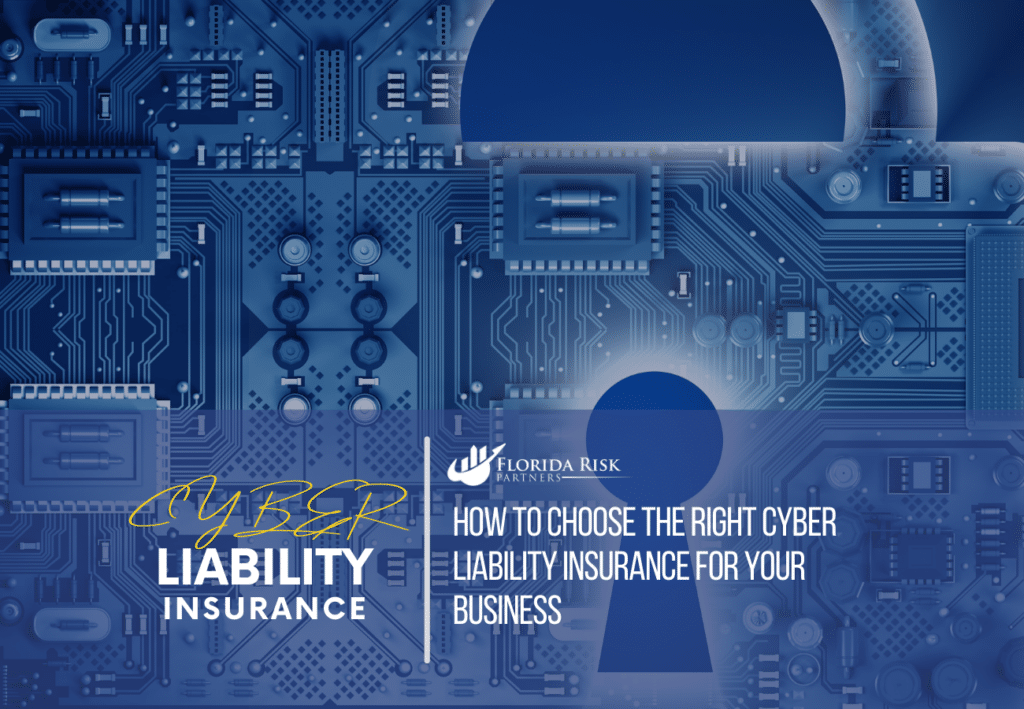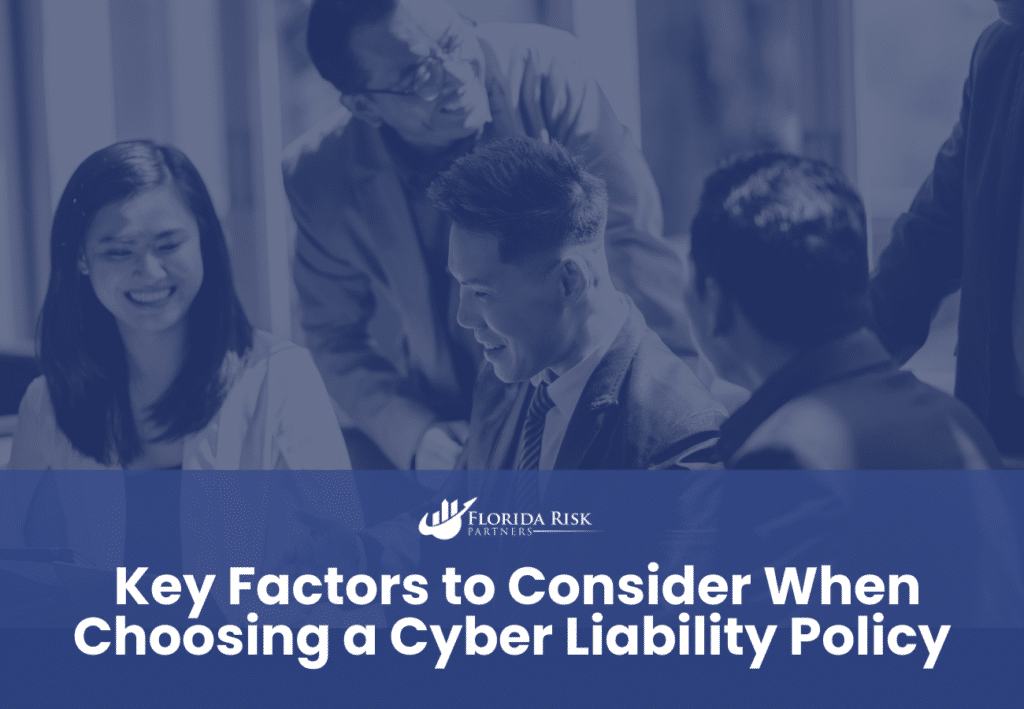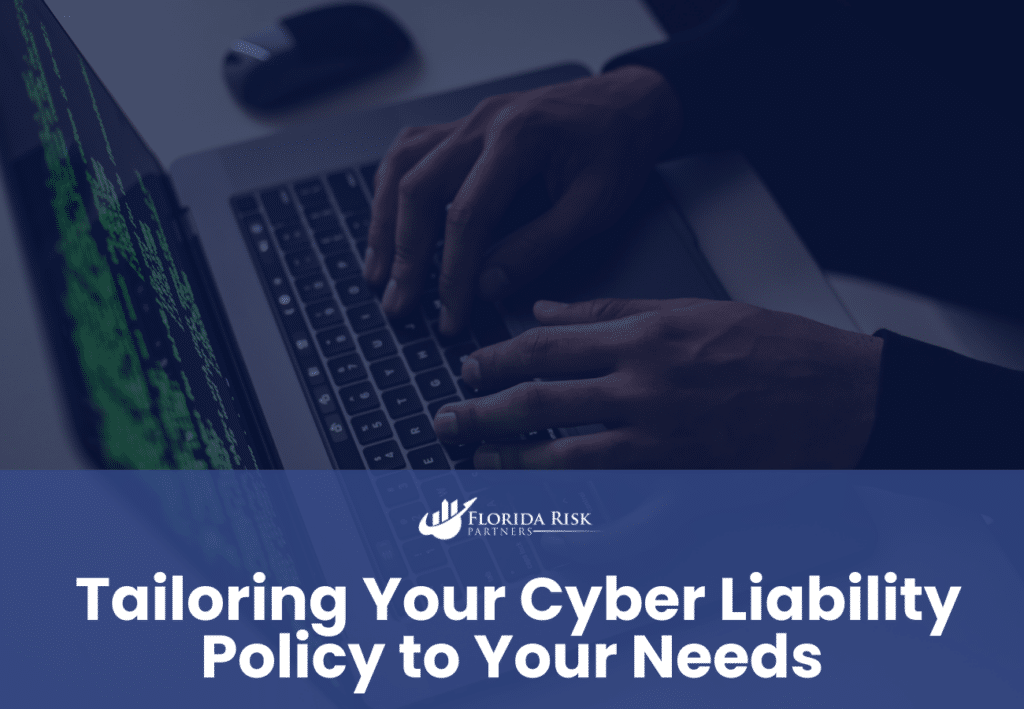-
Main Office: 1434 E. Bloomingdale Ave Valrico, FL 33596-6110
-
Phone: (888) 601-6660
-
Email: info@floridariskpartners.com

At a time where cyber threats are an everyday reality, protecting your business from data breaches, ransomware attacks, and other cyber risks is essential. While implementing robust cybersecurity measures is crucial, no system is foolproof. That’s where cyber liability insurance comes in, offering a financial safety net to help your business recover from the costs of a cyber incident.
But not all cyber liability policies are created equal. Choosing the right one requires careful consideration of your business’s unique needs, risks, and operations. In this guide, we’ll break down how to evaluate and select the best cyber liability insurance policy for your business.
Why Choosing the Right Policy Matters
The right cyber liability insurance policy can make the difference between recovering from a cyberattack and struggling to keep your business afloat. Cyber incidents can lead to significant financial losses, including:
- Business Interruption: Revenue lost during downtime caused by a ransomware attack or system outage.
- Data Breach Costs: Expenses related to notifying affected parties, offering credit monitoring, and investigating the breach.
- Regulatory Fines: Penalties for failing to comply with data protection laws like GDPR or CCPA.
- Legal Liabilities: Settlements and court costs if your business is sued over a cyber incident.
Without adequate coverage, these costs can quickly overwhelm your resources, making it vital to select a policy tailored to your needs.
Key Factors to Consider When Choosing a Cyber Liability Policy
When evaluating cyber liability insurance policies, it’s important to understand the features and limitations of each option. Below are the key factors to consider.
Coverage Limits and Sublimits
Policy limits refer to the maximum amount your insurer will pay for a covered claim, while sublimits cap payouts for specific types of losses, such as ransomware payments or breach notification costs.
What to Look For:
- Ensure the overall policy limit is sufficient to cover your potential losses in a worst-case scenario.
- Review sublimits to ensure critical areas, like business interruption or regulatory fines, are adequately covered.
Example:
If your policy has a $1 million limit but a $50,000 sublimit for ransomware payments, you may find yourself underinsured if an attack demands a six-figure ransom.
First-Party vs. Third-Party Coverage
Cyber liability insurance typically includes both first-party coverage and third-party coverage. Understanding the distinction is essential for selecting the right policy.
- First-party coverage protects your business from direct losses, such as data recovery costs, business interruption, and breach notifications.
- Third-party coverage shields you from liabilities if a cyber incident affects others, such as customers, vendors, or partners.
What to Look For:
Ensure the policy provides robust protection in both areas, especially if your business handles sensitive customer data or relies heavily on third-party vendors.
Retroactive Coverage
Cyber incidents are often discovered months after they occur, making retroactive coverage an essential feature of any policy. This coverage applies to incidents that occurred before the policy was purchased but were discovered afterward.
What to Look For:
- Check the policy’s retroactive date to ensure it aligns with your operational history.
- If your business has handled sensitive data for several years, choose a policy with a retroactive date that extends far enough to cover past risks.
Incident Response Services
One of the most valuable features of cyber liability insurance is access to incident response services. These resources help you respond quickly and effectively to a cyber incident, minimizing damage and downtime.
What to Look For:
- Ensure the policy includes 24/7 access to a breach response team.
- Confirm that pre-approved vendors, such as forensic experts, legal counsel, and public relations specialists, are included.
Why It Matters:
Immediate access to professionals can significantly reduce the financial and reputational impact of a cyber incident.

Exclusions and Limitations
All insurance policies include exclusions—situations or types of losses that aren’t covered. Understanding these exclusions is critical to avoid surprises when filing a claim.
Common Exclusions:
- Known Vulnerabilities: Incidents caused by unpatched software or ignored risks may not be covered.
- Employee Misconduct: Intentional acts by employees, such as data theft, are typically excluded.
- Acts of War or Terrorism: Cyberattacks linked to war or terrorism may fall outside the scope of coverage.
What to Look For:
Review the policy’s exclusions carefully and work with your broker to address gaps through endorsements or additional coverage.
Tailoring Your Cyber Liability Policy to Your Needs
No two businesses are alike, and your cyber liability policy should reflect the specific risks and operations of your company. Below are steps to customize your coverage.
Conduct a Risk Assessment
A thorough cyber risk assessment is the foundation of any effective insurance policy. This process helps you identify vulnerabilities, evaluate the potential impact of a cyber incident, and prioritize coverage needs.
Key Areas to Assess:
- The type of data you handle (e.g., customer financial information, healthcare records).
- Your reliance on digital systems and third-party vendors.
- The potential financial impact of downtime or data loss.

Choose Optional Endorsements
Many insurers offer optional endorsements that allow you to expand your coverage to address specific risks. Common endorsements include:
- Social Engineering Fraud: Covers losses from scams that trick employees into transferring funds or sharing sensitive information.
- Dependent Business Interruption: Protects against losses caused by third-party vendor outages.
- Reputation Damage Coverage: Provides funds to rebuild your brand after a cyber incident.
Why It Matters:
Endorsements can help fill gaps in your policy, ensuring comprehensive protection for your business.
Set Realistic Deductibles
The deductible is the amount you must pay out of pocket before your insurance coverage kicks in. Balancing affordability with protection is key.
What to Consider:
- Choose a deductible that aligns with your cash flow and risk tolerance.
- Higher deductibles may lower premiums but increase your financial burden during a claim.
Work with a Knowledgeable Broker
Navigating the complexities of cyber liability insurance can be challenging. A knowledgeable broker can help you:
- Compare policies from multiple insurers.
- Identify coverage gaps and tailor the policy to your needs.
- Ensure compliance with regulatory and contractual obligations.
Taking the Next Step
Selecting the right cyber liability insurance policy is an investment in your business’s resilience and long-term success. By evaluating your risks, understanding coverage options, and working with experts, you can ensure your business is protected from the financial fallout of cyber incidents.
To learn more about how to tailor a cyber liability insurance policy to your unique needs, visit our detailed guide: What Does Cyber Liability Insurance Cover?. This resource provides in-depth insights into the coverage areas and features that matter most for businesses in today’s digital landscape.
Download Our Complimentary Guide to Purchasing Cyberliability Insurance
Don’t leave your business vulnerable to cyber risks. Take the first step toward comprehensive protection today.
Call Us Or
Schedule an Appointment
Select an agent below to view our online calendars and select a day and time that works best for you or call us directly at 888-601-6660. When you use our online calendars, you will receive an email with more information.



